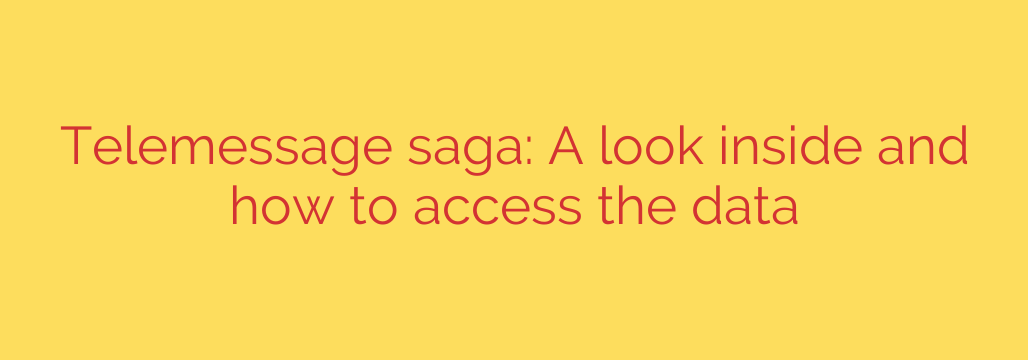
The Telemessage Data Breach Explained: What Went Wrong and How to Secure Your Data
A significant data breach at the mobile communications firm Telemessage has exposed a vast trove of sensitive corporate and personal data, serving as a critical reminder of the security risks inherent in our digital supply chains. This incident affects not just Telemessage itself, but also the numerous high-profile companies that relied on its services for message archiving and compliance.
Understanding the full scope of this breach is essential for any business leader, IT professional, or individual concerned about data privacy.
What is Telemessage and Why Does This Breach Matter?
Telemessage is a company that provides tools for capturing and archiving mobile communications. Many businesses, particularly those in heavily regulated industries like finance and healthcare, use its services to comply with legal requirements that mandate the storage of all business-related communications, including text messages, WhatsApp chats, and other mobile interactions.
The gravity of this breach stems from the nature of the data Telemessage handles. The platform was a central repository for highly sensitive, private, and often legally privileged conversations from a wide range of corporate clients. When this data is exposed, the consequences can be severe, ranging from regulatory fines to significant reputational damage and legal liability.
Anatomy of the Breach: How Did It Happen?
The root cause of this massive data leak appears to be a series of critically misconfigured Amazon Web Services (AWS) servers. Security researchers discovered that at least one of these servers, which stored archived message data, was left publicly accessible on the internet without a password.
This oversight meant that anyone who knew where to look could access the stored information directly. The breach wasn’t the result of a sophisticated hacking operation but rather a fundamental failure in basic cloud security protocols. The exposed infrastructure included:
- An Elasticsearch database
- A Kibana dashboard for data visualization
- A Logstash instance for data processing
This trio of tools, often used together, held terabytes of data that should have been secured behind robust authentication and network access controls.
What Information Was Exposed?
The scale of the exposed data is staggering. Because Telemessage archives the full content of messages, the leak contained far more than just metadata. The compromised information includes, but is not limited to:
- Full content of text messages (SMS) and multimedia messages (MMS)
- Archived chat data from platforms like WhatsApp
- Employee and user account information, including full names, phone numbers, and email addresses
- Administrative user credentials for the Telemessage system
- Sensitive corporate data discussed in private employee conversations
The exposure of message content is particularly damaging, as these conversations can contain trade secrets, financial details, legal strategies, and personal information about employees and clients.
Actionable Security Measures for Your Organization
This incident highlights the critical importance of vendor security and internal data handling policies. Whether you were directly affected by this breach or not, it offers crucial lessons for protecting your organization’s digital assets.
1. Scrutinize Your Third-Party Vendors
Your company’s security is only as strong as its weakest link, which is often a third-party vendor. Before engaging any service that will handle sensitive data, conduct a thorough security assessment. Ask pointed questions about their data encryption, access control policies, and incident response plans. Never assume a vendor is secure just because they are well-known.
2. Implement a “Zero Trust” Security Model
The core principle of Zero Trust is to “never trust, always verify.” This means no user or system—whether inside or outside your network—should be trusted by default. Access to sensitive resources should require strict identity verification and be granted on a least-privilege basis. This approach could have prevented the public exposure of the Telemessage servers.
3. Enforce End-to-End Encryption
Ensure that any communication platform used for business purposes employs strong, end-to-end encryption. This means that only the sender and the intended recipient can read the message content. While Telemessage’s service was designed to archive messages for compliance (bypassing E2EE by design), it underscores the need to ensure that archived data is encrypted at rest with robust access controls.
4. Conduct Regular Security Audits
Proactively search for vulnerabilities in your own infrastructure and that of your key vendors. Regular penetration testing and cloud security posture management (CSPM) can identify misconfigurations—like a publicly exposed database—before malicious actors do. Make security audits a non-negotiable, recurring part of your IT operations.
5. Educate Your Team on Phishing and Social Engineering
Following any major data breach, there is a sharp increase in targeted phishing attacks. Hackers use the leaked information (names, emails, phone numbers) to create highly convincing scams. Train your employees to be skeptical of unsolicited emails or messages, especially those that create a sense of urgency or ask for credentials.
The Telemessage breach is a stark reminder that in today’s interconnected world, data security is a shared responsibility. By taking proactive steps to fortify your defenses and diligently vetting your partners, you can build a more resilient and secure digital environment for your business.
Source: https://go.theregister.com/feed/www.theregister.com/2025/08/10/telemessage_archive_online/








